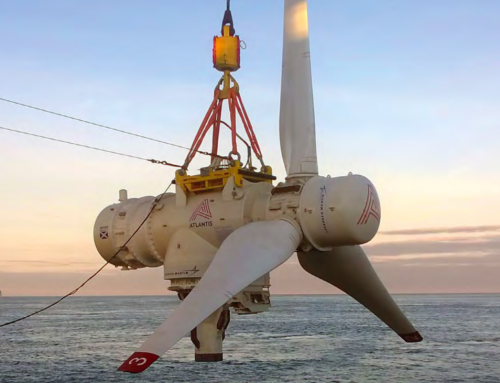By Julian Singer
Many people have dreamt of generating electricity from waves but no one has yet shown it to be commercially successful. Anyone returning from a seaside vacation knows the power of waves, but no one has yet found a system that is rugged enough to withstand the large forces they can generate at the same time as providing a reasonable amount of electrical power for the weight and cost needed.
Bombora Wave is the latest to try. Bombora is a company founded in Western Australia in 2012, based on the experiments made by two brothers, Glen and Shawn Ryan, in their swimming pool. They showed how a flexible rubber membrane mounted on a rigid bowl would move in and out with the passage of waves, like a trampoline. When moving in, it displaces air which can be used to drive a generator. When moving out, one-way valves allow it to draw air from a reservoir.
Bombora has constructed such a device near Pembroke Docks in Wales. There are twenty bowls, or cells, which drive a single turbine with a capacity of 1.5MW. Once tested it will be placed on the sea bed in 15 m of water about a kilometre off the coast with an electrical cable to bring the power onshore. It is intended as a demonstration model and will be removed within a year. Currently, the company’s only other project is one proposed off Lanzarote in the Canary Islands.

An artist’s drawing of the mWaveTM on the seabed. The total length is 75 metres, width 20 m and weight 850 tons. The turbine is in the nose (www.bomborawave.com)
The company foresees three versions of its mWaveTM system. The first will be fixed on the seabed, as in the Pembroke example. This is suitable for water depths up to 25m. In the second version, it will be installed on the underwater spars of a semi-submersible platform such as those used for oil rigs, but without the drilling rig. This floating structure is suitable for water depths up to 50m. The third version is the “Integrated Semi-submersible Platform with Innovative Renewable Energy” (InSPIRE), a joint venture with TechnipFMC, in which the semi-submersible also holds a wind turbine, thus reducing costs by sharing infrastructure and electrical cables and smoothing the power output.
But first Bombora needs to show that its system works, and then that it can survive with minimum maintenance. History has not been kind to wave power developers. In the early 2000s and based on research at the University of Edinburgh, Pelamis Wave Power developed a mechanical sea snake that moved with the waves at the surface. It had maintenance problems and was eventually withdrawn. Carnegie New Energy, an Australian company, uses a set of buoyant disks that are tethered to the sea floor, with the movement against the tether used to generate electricity. Finally, Ocean Power Technologies, an American company, uses a floating buoy about 13m tall in which an outer cylinder moves against the main body which is tethered to the sea floor.
The basic problem is that the equipment has to be rugged enough to operate in the marine environment, and to withstand the very large power that waves occasionally generate. Maintenance is also difficult, so that the overall cost is high for the amount of electricity generated. From knowledge of the energy content of waves, Professor David MacKay showed that even if half the UK’s Atlantic coast was lined with wave generators they would still only generate 4kWh per person per day[1].
Can Bombora get over these problems? The mWave will at least be set on the sea bed or attached to a large platform, thus avoiding the extremes of wave action. It is being designed with maintenance in mind, for example making it possible to remove an individual cell without affecting the remainder. There is no sophisticated or new technology involved in construction. Its most likely application would be near islands or coastal locations that are either remote or not want unsightly wind farms nearby.
Bombora is a private company with three strategic partners: Enzen, an energy solutions company with headquarters in India; Mitsui O.S.K. Lines, a Japanese shipping company looking to diversify into renewable energy; and TechnipFMC. It received a grant of £10.3m from the EU in 2018 and has support from the UK Offshore Renewable Energy Catapult.
[1] “Sustainable Energy – without the hot air”, Professor David MacKay, 2009. The average daily consumption of a UK household is about 10 kWh per day (excluding non-residential uses).



